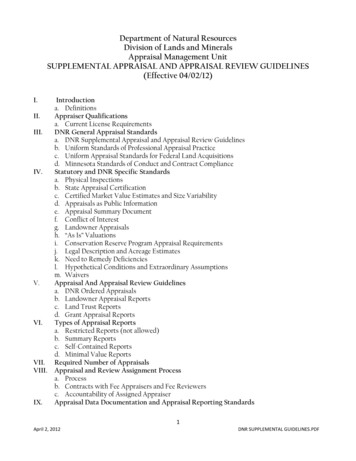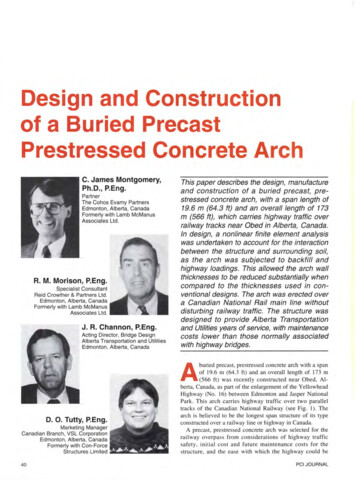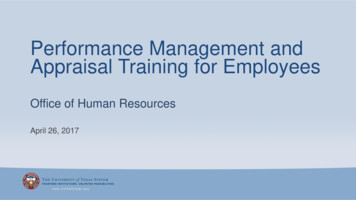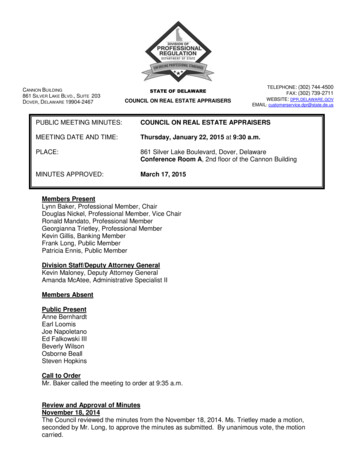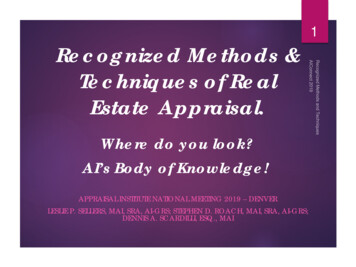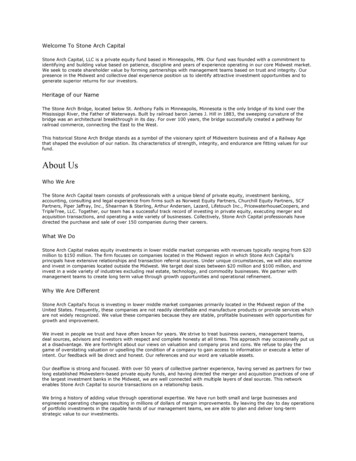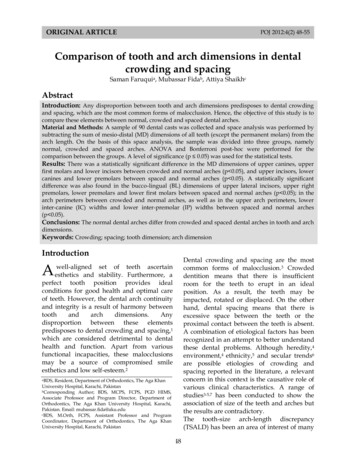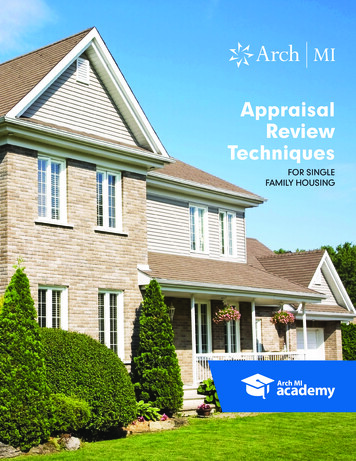
Transcription
AppraisalReviewTechniquesFOR SINGLEFAMILY HOUSING
APPRAISAL REVIEW TECHNIQUES FOR SINGLE FAMILY HOUSING 2020 Arch Mortgage Insurance Company. All Rights Reserved.1
Table of ContentsIntroduction to Appraisal Review for Single-Family Residences . 3CHAPTER ONE . 5Uniform Residential Appraisal Report (URAR) . 5Section 1 — Subject . 6Section 2 — Contract . 10Section 3 — Neighborhood . 11Section 4 — Site . 14Section 5 — Improvement . 18Section 6 — Sales Comparison Approach . 24Section 7 — Reconciliation . 34Section 8 — Additional Comments . 36Section 9 — Cost Approach . 37Section 10 — Income Approach. 41Section 11 — Planned Unit Development (Pud) Information. 43Section 12 — Appraisal Exhibits . 47Market Conditions Addendum . 48CHAPTER TWO . 51Forms . 51Arch Mortgage Insurance Company is providing this training, Appraisal Review Techniques, to you for use as a training tool only.These materials are not intended nor should they be relied upon for any other purpose, including underwriting actual mortgageloans without independent verification and testing by your in-house quality control and/or compliance personnel or actualreview of documents which may be presented in the materials. All materials presented are samples for illustrative purposesonly.This module is intended to give guidance on the review of a single-family appraisal. This module does not however, infersalability of the collateral. Refer to investor guidelines and/or Arch Mortgage Insurance Company underwriting guidelines forspecific collateral requirements.This appraisal review techniques discussion is based on the forms currently in use in the residential mortgage market. However,new forms or new versions of existing forms, may be published over time, and it is important for the loan underwriter,appraiser and other mortgage industry professionals to use current forms for each loan.APPRAISAL REVIEW TECHNIQUES FOR SINGLE FAMILY HOUSING 2020 Arch Mortgage Insurance Company. All Rights Reserved.2
INTRODUCTION TO APPRAISAL REVIEW FOR SINGLE-FAMILY RESIDENCESUniform Residential Appraisal Report Fannie Mae Form 1004/Freddie Mac Form 70A critical step in the mortgage origination process is the review of the property appraisal report. Theevaluation of the property is a vital component in the analysis of a mortgage as the collateral is theultimate security for the loan. Underwriters are expected to place as much emphasis on appraisal reviewas they do on qualifying the borrower’s creditworthiness. Mortgage underwriters must have a solidunderstanding of the appraisal process and they should also be versed in Fannie Mae and Freddie Macrequirements and procedures so the loan package will be eligible to these agencies. Because the lenderis generally accountable to Fannie Mae, Freddie Mac or any other secondary market investor for theaccuracy of the appraisal, the ultimate responsibility falls on the mortgage underwriter. LenderLenders are responsible for selecting an appraiser who has the knowledge and experience requiredto perform a professional-quality appraisal in a specific geographic location for the particularproperty type for which the lender needs an appraisal. The appraiser must also have knowledgeabout, and access to, the necessary and appropriate data sources for the area in which the appraisalassignment is located. Lenders are solely accountable for the performance of the appraisers theyselect and must make all required representations and warranties related to the appraisal andcondition of the property. AppraiserThe appraiser is to provide complete and accurate reports; to report neighborhood and propertyconditions in factual and specific terms; to be impartial and specific in describing favorable orunfavorable factors; and to avoid the use of subjective, racial or stereotypical terms, phrases orcomments in the appraisal report. The opinion of value must represent the appraiser’s professionalconclusion based on market data, logical analysis and judgment.APPRAISAL REVIEW TECHNIQUES FOR SINGLE FAMILY HOUSING 2020 Arch Mortgage Insurance Company. All Rights Reserved.3
Underwriter/ReviewerIt is the underwriter’s responsibility to review the appraisal in its entirety for completeness, accuracyand consistency to ensure that it provides an adequate determination of property value, regardlessof what message is received from any automated underwriting system or other collateralassessment tool.When an appraisal report is deficient, additional clarification of information or methodology must berequested from the appraiser to make an informed decision. The estimate of value must be based onadequate data, logical analysis and judgment, and it must present a clear and reasonable conclusion.This training module is designed to convey basic appraisal theory and techniques that will provide thereviewer with a basis for appraisal review applications.The most widely used and universally accepted appraisal form is the Uniform Residential AppraisalReport (URAR), also known as Fannie Mae Form 1004/Freddie Mac Form 70. The URAR, which is sixpages long, is considered the industry standard for appraisals. The first page of the URAR identifies thesubject property and provides the reviewer with a complete picture of the subject’s sales contract,neighborhood, site and improvements along with commentary on characteristics that affect thesubject’s value. The second page presents the valuation section or the Sales Comparison Approach,Reconciliation and value conclusion. The third page provides optional Cost and Income Approaches tovalue and project information, if applicable. The remaining next two pages display the appraiser’s Scopeof Work, Statement of Assumptions and Limiting Conditions and the appraiser’s Certification andSignature sections.Accordingly, the scope of Chapter 1 of this module is limited to the use of the URAR for single-familyresidential appraisals and what follows is a section-by-section description of the URAR. Chapter 1 isintended to describe the data and commentary that is expected in each section and highlight somecommon issues that may arise in the review of a URAR.Samples of the appraisal forms discussed in this manual are included in Chapter Two.The IMPORTANT NOTES will call attention to concerns and common issues that may surface duringthe review of an appraisal.APPRAISAL REVIEW TECHNIQUES FOR SINGLE FAMILY HOUSING 2020 Arch Mortgage Insurance Company. All Rights Reserved.4
CHAPTER ONEUNIFORM RESIDENTIAL APPRAISAL REPORTPage 1 — URARPURPOSE: The first line item on Page 1 of the URAR describes the purpose of the appraisal report, theintended user and refers to market value. Although there are numerous definitions of value, thedefinition of market value is of key importance in the residential mortgage appraisal process.From the appraiser’s viewpoint, market value is defined as follows: The most probable price which aproperty should bring in a competitive and open market under all conditions requisite to a fair sale, thebuyer and seller, each acting prudently, knowledgeably and assuming the price is not affected by unduestimulus.Implicit in this definition is the consummation of a sale as of a specific date and passing of title fromseller to buyer under the following conditions: Buyer and seller are typically motivated.Both parties are well-informed or well-advised, and each party is acting in what they consider theirown best interest.A reasonable time is allowed for exposure in the open market.Payment is made in cash or its equivalent.Financing, if any, is on terms generally available in the community, at the specified date and typicalfor the property type in its locale.The price represents a normal consideration for the property sold unaffected by special financingamounts and/or terms, services, fees, costs or credits incurred in the transaction.APPRAISAL REVIEW TECHNIQUES FOR SINGLE FAMILY HOUSING 2020 Arch Mortgage Insurance Company. All Rights Reserved.5
SECTION 1 — SUBJECTThe purpose of this section is to identify the subject property, to describe the property rights to beappraised, assignment type, lender/client and data sources. Often the basic information requested isnot available to the appraiser unless provided by the lender or obtained by direct review of the titledocuments.The appraisal must clearly identify the subject property by stating the complete:Property Address — Within this section, the appraiser must identify the subject by its completeproperty address, which includes the physical street location, city, state and ZIP code. A post office box(P.O. Box) is not an acceptable address.Borrower — The individual or individuals applying for the mortgage on the subject property.Owner of Public Record — The owner of the property according to the records of the county or othergovernmental jurisdictions such as a township, borough or parish. If the transaction is a purchase, thisshould be the seller as listed on the sales contract. If the transaction is a refinance, this should be theborrower.County — This will typically indicate where the subject property is located and the recording jurisdiction.Legal Description — A method of geographically identifying a parcel of land, that is acceptable in a courtof law. If the legal description is lengthy, it may be attached to the appraisal report.APPRAISAL REVIEW TECHNIQUES FOR SINGLE FAMILY HOUSING 2020 Arch Mortgage Insurance Company. All Rights Reserved.6
Assessor’s Parcel Number (APN) — The APN is the county’s tax identification number for the property.In some cases, the subject property may consist of more than one parcel with two or more APNnumbers. In other instances, the property may be new or proposed construction and an APN has not yetbeen issued. In these cases, the APN field may be blank or the appraiser has indicated "None." A fewmarkets do not use APN numbers, but it is still necessary to report the level of similar alternativeinformation in these areas for this item.Tax Year — The current or last reported tax assessment year for the subject property.R. E. Taxes — This field contains the current or last reported real estate tax assessment on theproperty. This field should contain the dollar amount of annual taxes levied on the property.Neighborhood Name — This descriptive field helps to further identify the property by naming thesubdivision, development, project or neighborhood district where the property is located.Map Reference — Another method for locating the subject property often associated with local areamaps (such as Thomas Brothers Maps, Hagstrom Maps, Multiple Listing Service (MLS) and others) orreference materials.Census Tract — Another method for approximate location of the subject property within a geographicarea, based on population thresholds as established by the U.S. Census Bureau. Census Tract geographicareas also have applications for Home Mortgage Disclosure Act (HMDA) reporting.Occupant — This field indicates whether the current occupant of the property is the owner or tenant, orif the property is now vacant.APPRAISAL REVIEW TECHNIQUES FOR SINGLE FAMILY HOUSING 2020 Arch Mortgage Insurance Company. All Rights Reserved.7
Special Assessments — This field is reserved for any taxes, bonds or levies against the property asidefrom real estate taxes and homeowner association (HOA) or project dues and fees, which can vary intype from region to region. These assessments are typically for municipal improvement bonds ordevelopment surcharges and could include such items as water and sewer improvements, street lightingand park and recreation development. These fees are typically annualized and paid over a period ofyears (for example, from five to 25 years). If the subject has a large special assessment and thecomparables do not, then an adjustment is likely in order in the Sales Comparison Approach on Page 2of the URAR.PUD — This checkbox is checked if the subject is located in a Planned Unit Development (PUD). PUD — A type of residential, commercial or industrial development (or a combination thereof) inwhich the improvements are clustered in a pre-designed layout that includes common areas.Individual properties (the land and attached improvements) are owned in fee, while the commonareas are placed in joint ownership. The common areas can consist of any number of items, buttypically include greenbelt areas, private streets, parking facilities and recreation amenities. Thereare usually mandatory fees or dues assessed to the property owner for maintenance of thesecommon areas.IMPORTANT NOTE: PUD denotes a type of land use. It does not describe the physical characteristicsof an individual property. It can also describe a type of ownership as individually owned propertieslocated within PUD developments. One of the key characteristics of PUD ownership is that someportion of the land is actually included in the ownership rights of the subject. Other types ofownership, such as condominiums and cooperatives, typically do not include individual ownership ofland, which is owned in common by all individual unit owners.HOA — This field records the dollar amount of homeowners association (HOA) dues that are paid forthe maintenance of common areas in PUD and condominium ownership. This is reported as either a peryear or a per-month figure as indicated by the box the appraiser checks.APPRAISAL REVIEW TECHNIQUES FOR SINGLE FAMILY HOUSING 2020 Arch Mortgage Insurance Company. All Rights Reserved.8
Property Rights Appraised — The concept of “rights” refers to the degree and type of ownershipinterest in the subject property. The broadest categories are: Fee Simple — This denotes ownership of all the bundle of rights in a parcel of real property (such asthe right to use the real estate, to sell it, to lease it, to give it away or the option to choose toexercise all or none of these rights), subject only to the limitations of the powers of government. Leasehold — The right of use and occupancy of a property for a stated term under prescribedcircumstances by virtue of a lease agreement.Assignment Type — This provides the reviewer with information on the type of transaction associatedwith the subject property and appraisal, either Purchase, Refinance or Other. If Other is chosen, adescription is required.Lender/Client — Generally indicates who ordered the appraisal report and who the intended users are.The Lender/Client should be the submitting lender or third-party originator.Address — This refers to the lender’s address. Comparison of the lender address to that of theappraiser’s and subject’s addresses can be revealing as to the level of local market knowledge andmotivations applied to the appraisal. Detailed address information for the appraiser is located on Page 6of the URAR.Is the subject property currently offered for sale or has it been offered for sale in the twelve monthsprior to the effective date of this appraisal? Yes No — The appraiser must research and indicate ifthe property has been offered for sale within 12 months prior to the effective date of appraisal.Report data source(s) used, offering price(s), and date(s) — If offered for sale, the listing details shouldbe provided regarding the source of this data, typically from local MLS, including list price and dates. Theappraiser must also enter the days on market (DOM) for the subject property.APPRAISAL REVIEW TECHNIQUES FOR SINGLE FAMILY HOUSING 2020 Arch Mortgage Insurance Company. All Rights Reserved.9
SECTION 2 — CONTRACTThis section of the appraisal report provides information on the current purchase contract for thesubject property being appraised.I did did not analyze the contract for sale for the subject purchase transaction, etc. — Firstsection provides input from the appraiser to indicate that he or she did or did not analyze the subject’spurchase or sales agreement; and includes several spaces to explain the analysis, and if not analyzed,why not. The appraiser must also indicate the type of sale for this transaction (for example, real estateowned (REO) sale, estate sale, arm’s length sale, etc.)Contract Price — This represents the subject’s agreed-to sale price from the sales contract or purchaseagreement.Date of Contract — This represents the contract date from the sales contract or purchase agreement.Is the property seller owner of public record? Yes No; Data Source(s) — This is an important itemand should match with the similar item within the Subject section above. If these two items do notmatch, then this should be further researched and clarified.Is there any financial assistance (loan charges, sales concessions, gift or down payment assistance,etc.) to be paid by any party on behalf of the borrower? Yes No; If Yes, report the total dollaramount and describe items to be paid — This information should indicate whether there are any loancharges, sales concessions or gifts paid by seller (or any other party who has a financial interest in thesale or financing of the subject property). The existence of this activity may indicate soft marketconditions or marketability issues associated with the subject, especially if not normal and customary forthe market. Some of these items or activities may also have a direct impact on the subject’s appraisedvalue. The question above further stresses the importance of the appraiser obtaining and analyzing acomplete copy of the purchase agreement.APPRAISAL REVIEW TECHNIQUES FOR SINGLE FAMILY HOUSING 2020 Arch Mortgage Insurance Company. All Rights Reserved.10
SECTION 3 — NEIGHBORHOODThis section introduces information on the subject property’s location within the surrounding area orneighborhood. The purpose of the neighborhood analysis is to identify a contiguous area that is subjectto the same influences (based on common characteristics, trends, price, age and land use) as the subjectproperty. The analysis should clearly define the area from which comparable sales are selected andprovide boundaries such as streets, rivers, etc. The analysis should identify any characteristics that mightinfluence market conditions of the properties within the neighborhood. The reviewer must be satisfiedthat the neighborhood will be acceptable to a sufficient number of buyers to support an active, ongoingmarket for the property.Neighborhood Characteristics — Subsections within the Neighborhood section are displayed anddiscussed as follows: Location — Urban relates to a city, Suburban to an area adjacent to a city and Rural is anythingbeyond the suburban area. Rural areas are typically less than 25% developed and exhibit slowergrowth and longer marketing times than Urban or Suburban neighborhoods. Built-Up — Indicates the extent to which the neighborhood has been developed. If Under 25% ismarked, the reviewer should examine the development progress and its impact on property values,and this should be addressed in detail by the appraiser. Growth — This information helps determine the current stage in the life cycle of the neighborhood.Growth is generally Rapid in new and developing neighborhoods. Once all available land isdeveloped, growth tends to reach equilibrium or is Stable. Growth continues even in older anddeveloped neighborhoods via a change in land use or redevelopment. There should be an adequateexplanation if Slow is indicated.One-Unit Housing Trends — Within the Neighborhood section, the following key areas are discussed: Property Values — Increasing or Declining values require comments and should correlate to Date ofSale/Time Adjustments found in the Sales Comparison Approach on Page 2 of the URAR. In adeclining market, a determination should be made by the reviewer as to whether maximumfinancing is acceptable.APPRAISAL REVIEW TECHNIQUES FOR SINGLE FAMILY HOUSING 2020 Arch Mortgage Insurance Company. All Rights Reserved.11
Demand/Supply — There should be an adequate explanation for an Over Supply and a statement onits impact on value and marketability in the area Market Conditions comment at the end of thesection. Marketing Time — If “Over 6 months” is marked, the appraisal should provide an adequatedescription of the subject’s marketability. Longer marketing times often indicate a possibility ofdeclining values. There can also be a seasonal aspect associated with this item due to climaticaspects. For example, marketing times in desert areas during the summer months may be longerthan in the winter.One-Unit Housing — This field provides a description of the housing stock in the subject’s neighborhood.The appraiser should present the low and high values to establish a range for the following components: Price — The sales prices of the comparable sales and the appraised value of the subject should bewithin the indicated Low-High range. The appraiser should not consider isolated extremes as thisindicates the low and high price range where typical sales activity occurs. If the subject’s indicatedvalue is at the extreme upper end or outside the range established, it could indicate an overimprovement. The appraiser is expected to comment on any divergence and offer an opinion as tothe impact on marketability. Age — The reviewer should expect the actual age of the subject property to be near or within theage range of other properties in the neighborhood or, if it is not, the age should be explained in thecommentary at the end of this section. Low/High — This is where the appraiser puts the low and high price range where typical salesactivity occurs. Predominant Value — This line should present the most frequently occurring sale price and thetypical age of properties located within the subject’s neighborhood. The reviewer’s main concern iswhether the subject property conforms to the neighborhood indicators.APPRAISAL REVIEW TECHNIQUES FOR SINGLE FAMILY HOUSING 2020 Arch Mortgage Insurance Company. All Rights Reserved.12
Present Land Use % — This subsection provides the percentage distribution of land use and helps thereviewer determine whether the subject (a residential property) is negatively affected by other landuses such as multi-family, commercial, industrial, etc. The total of all uses should equal 100%.Neighborhood Boundaries — These important comments identify a contiguous area that is subject tothe same influences (based on common characteristics) as the subject. The appraiser should provide anoutline of the neighborhood boundaries, which should be clearly delineated using North, South, Eastand West and provide specific boundaries such as major streets, hills, rivers or railroads. Comparablesales should be within these boundaries and if they're not, an explanation is required. Urbanneighborhoods would typically have smaller and better-defined neighborhoods, while ruralneighborhoods may be more general and larger in geographic size.Neighborhood Description — Provides comments regarding neighborhood characteristics andidentification, including boundaries, neighborhood characteristics and marketability. This may includecomments on the neighborhood life cycle, land use, proximity to employment centers, amenities andany adverse environmental influences.Market Conditions — This comment section is where the appraiser is expected to provide appropriatesupport for the Neighborhood Characteristics, Trends, Price and Age and Land Use categories above.Additionally, comments can also include demand and supply, marketing times and data on competitiveproperties in the neighborhood.Further analysis can be found on the Market Conditions Report (Fannie Mae Form 1004MC/ FreddieMac Form 71).APPRAISAL REVIEW TECHNIQUES FOR SINGLE FAMILY HOUSING 2020 Arch Mortgage Insurance Company. All Rights Reserved.13
SECTION 4 — SITEThe reviewer should examine the items listed below and be assured that the property generallyconforms to the marketplace. In addition, any unusual or atypical characteristics for the subject site areaddressed and that any favorable or unfavorable situations have been explained by the appraiser in thecomments. Ideally, the subject’s site size, shape, use and amenities should be similar with those of otherneighborhood properties. This section also provides an opportunity for a cross-check of severalcharacteristics below in comparison to items on the sales grid on Page 2 of the URAR form within theSales Comparison Approach.Dimensions — This would provide measurements for the site, typically width and depth in the case of arectangular-shaped lot. For unusual-shaped sites, there may be multiple dimensions provided.Area — The appraiser must report the area as square feet if equal to or less than one acre (43,560square feet) or as acres if over one acre in size. A key consideration for this item is whether the subject’sarea is reasonably conforming and acceptable in the neighborhood? This is also a line item on the SalesComparison Approach on Page 2 of the URAR.Shape — This item would provide an indication of the shape for the subject site and would typically berectangular, but there may be unusual site shapes as well. Neighborhood conformity and acceptance areimportant for this item.APPRAISAL REVIEW TECHNIQUES FOR SINGLE FAMILY HOUSING 2020 Arch Mortgage Insurance Company. All Rights Reserved.14
View — If the subject site does in fact have a favorable view such as water, mountains, city, etc., it mayadd significant value compared to sites without such a view. Adverse views such as train tracks or powerlines may decrease the value. View amenities can be a little tricky to quantify from an appraisalperspective and can be even more difficult to confirm during the review process. View attributes arealso a line item and appear on the Sales Comparison Approach on Page 2 of the URAR. The appraisermust specify the overall view rating as Neutral (N), Beneficial (B) or Adverse (A), and provide at leastone, but no more than two, view factors to provide details about the overall view rating.Specific Zoning Classification — This would represent the specific site zoning code as established bylocal government. An example might be “R-1 Residential” rather than simply “Residential.”Zoning Description — A general statement to describe what the zoning permits such as one-unit andtwo-unit when the appraiser indicates specific zoning such as R-1, R-2, etc. From the example above, thedescription could be: Residential Use — one unit on a half-acre or less. If the zoning Description includesa reference to the minimum or maximum site size, this may also provide yet another opportunity tocross-check and confirm the site size on the sales grid from Page 2 of the URAR within the SalesComparison Approach.Zoning Compliance — One of the most important aspects to consider for the subject’s site is ZoningCompliance. Ideally, the first checkbox, "Legal," is marked. If the improvements do not represent a legal,conforming use, the appraisal must address this issue and its impact on the marketability and value ofthe subject. One of the most common zoning violations is the non-permitted addition or accessory unit.Lack of zoning, or no zoning, also requires an explanation from the appraiser.IMPORTANT NOTE: Some municipalities and many rural properties have no zoning regulations.APPRAISAL REVIEW TECHNIQUES FOR SINGLE FAMILY HOUSING 2020 Arch Mortgage Insurance Company. All Rights Reserved.15
Is the highest and best use of the subject as improved (or as proposed per plans and specifications)the present use? Yes No If No, describe — If the answer is “No,” the appraisal should provideverification that the property is suitable security for a residential loan and describe in detail. In suchcases, the GSEs will likely not purchase the mortgage. “Highest and best use” is defined as that use thatwould produce the greatest current value. If the subject’s highest and best use is not residential, thenthe URAR fo
reviewer with a basis for appraisal review applications. The most widely used and universally accepted appraisal form is the Uniform Residential Appraisal Report (URAR), also known as Fannie Mae Form 1004/Freddie Mac Form 70. The URAR, which is six pages long, is considered the industry standard for appraisals.
